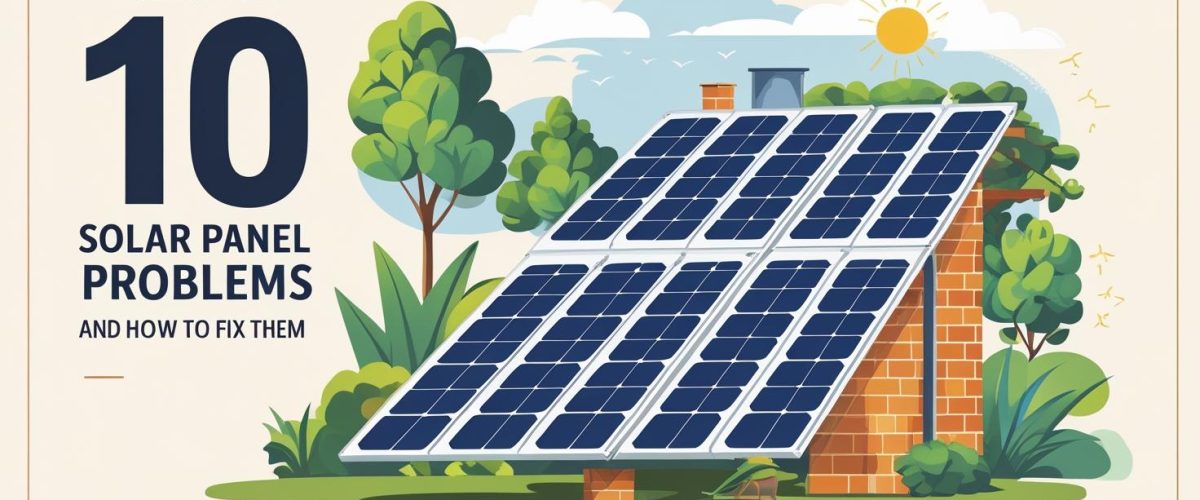Introduction
Solar power should feel like a set and forget solution but in reality, dust, heat, and wear can quietly reduce performance.
If your bill isn’t dropping or your output graph looks odd, you’re not alone. Many solar panel problems are easy to identify and fix without stress.
In this guide, we’ll cover the 10 most common solar problems in Pakistan especially those homeowners in Islamabad face and show you how to troubleshoot them safely. From dirty panels and shading to inverter faults and battery issues, you’ll learn practical steps, when to call a technician, and how to keep your system running efficiently year-round.
1. Dirty Panels
What’s happening: Dust, bird droppings, pollen, and urban pollution block sunlight, reducing efficiency by 10 to 30% during dry months.
How to fix it:
- Rinse with clean water and a soft brush or microfiber mop early morning or late evening.
- Avoid harsh chemicals and high-pressure jets that can damage seals.
- In Islamabad’s climate, clean every 2 to 4 weeks.
- Consider anti-soiling coatings for hard-to-reach rooftops.
Pro tip: Log output before and after cleaning to measure gains and adjust your cleaning schedule accordingly.
2. Loose Wiring & Connection Faults
What’s happening: DC connectors (MC4), junction boxes, or AC terminals loosen over time, causing intermittent output, arcing, or inverter errors.
How to fix it:
- Safely shut down the system (DC isolator, AC breaker).
- Have a certified technician inspect connectors, crimps, and junction boxes.
- Replace scorched connectors, tighten terminals to correct torque, and weatherproof exposed points.
Call a pro if: You smell burning plastic, see scorch marks, or hear crackling.
3. Inverter Malfunctions
What’s happening: The inverter converts DC to AC; faults can drop output to near zero. Causes include overheating, grid fluctuations, firmware bugs, or undersized inverters.
How to fix it:
- Check error codes on the display/app.
- Verify breaker positions, ensure ventilation, clean inverter filters, and update firmware.
- If faults persist, test strings, replace faulty components, or upgrade to a capacity-matched inverter.
Prevention: Shade the inverter, allow airflow, and use surge protection on the AC side.
4. Bypass Diode or String Mismatch
What’s happening: Faulty diodes or mismatched panels in a string cause losses and hot spots.
How to fix it:
- Use IV-curve testing or thermal imaging to locate weak modules.
- Replace the faulty panel or junction box.
- Keep all modules in a string the same model, wattage, and age.
Upgrade option: Add power optimizers or microinverters to reduce mismatch losses.
5. Hot Spots
What’s happening: Localized overheating from dirt, shading, or cell damage shortens panel life.
How to fix it:
- Clean panels, remove shading, and replace faulty modules.
- Check mounting pressure over-tightening can crack cells.
Prevention: Schedule annual thermographic inspections.
6. Micro Cracks in Cells
What’s happening: Tiny cracks from transport, hail, or temperature swings cause gradual power loss.
How to fix it:
- Confirm with electroluminescence (EL) or thermal scans.
- Replace heavily cracked modules.
Prevention: Use reputable brands, proper packaging, and wind-rated clamps.
7. Potential Induced Degradation (PID)
What’s happening: High voltage potential between cells and frame leaks charge, reducing output common in hot, humid climates.
How to fix it:
- Install anti-PID boxes.
- Improve grounding.
- Replace severely affected panels with PID-resistant models.
Prevention: Ensure correct system polarity and quality grounding.
8. Shading (Trees, Walls, Antennas)
What’s happening: Even a small shadow on one cell can reduce a whole string’s output.
How to fix it:
- Trim trees, relocate obstructions, or reconfigure strings.
- Add optimizers or microinverters for partial shading.
Quick win: Use a shade analysis app before seasonal changes.
9. Battery & Charge Controller Issues (Hybrid/Backup Systems)
What’s happening: Sulfation, poor balancing, or wrong charge settings reduce backup time.
How to fix it:
- Update firmware and verify charge profiles.
- Test capacity and balance cells.
- Replace aging batteries or faulty controllers.
Pro tip: Keep cycles shallow for longer battery life.
10. Mounting & Weather Damage
What’s happening: Loose racking, rust, UV damage, or seal failures lead to leaks and panel movement.
How to fix it:
- Torque-check rails and clamps.
- Replace rusted fasteners with stainless steel.
- Reseal roof penetrations and secure cables.
Prevention: Use wind rated designs and schedule regular roof inspections.
FAQS | Solar Panel Maintenance & Troubleshooting
Q1: How often should I clean my solar panels in Pakistan?
A: Every 2 to 4 weeks in dry months, or more often if your area has heavy dust or bird activity.
Q2: Can I fix inverter issues myself?
A: You can check ventilation, breakers, and firmware, but electrical repairs should be done by a licensed technician
Q3: Do micro-cracks in solar cells always reduce output?
A: Small cracks may have minimal impact, but they can worsen over time and cause long-term efficiency loss.
Q4: What’s the average lifespan of a solar panel?
A: Quality panels last 25 to 30 years, but output may reduce by 0.5 to 1% annually.
Q5: How do I know if my panels have PID?
A: Signs include sudden drops in output, especially in humid conditions. Testing by your installer can confirm.
Conclusion & Call to Action
Keeping solar panels efficient is simple with regular cleaning, quick fixes, and annual check ups. The solutions above can restore lost efficiency and extend system life.
If you’re in Islamabad or nearby, book a solar health check with FixSolarEnergy to diagnose issues, boost performance, and secure long-term savings.
Ready to get your system producing at its best? Request an inspection today.


